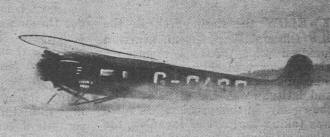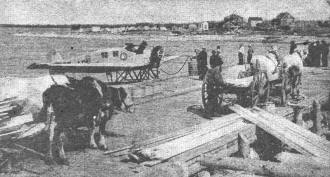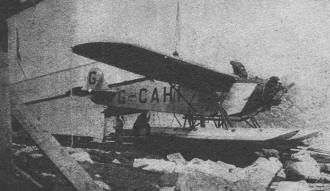|
Canada has always been a good, reliable neighbor to the United States
of America. Our cultures stem from common western European roots.
Being a dominion (at the time) of
England, Canada was drawn into World War II in September 1939,
a week after England's declaration of war against Germany. Hitler
invaded Poland and began his move across Europe on September 1 of
that year. The U.S. provided equipment and troop training to Canadian
troops up through and beyond when the Japanese navy bombed Pearl
Harbor on December 7, 1941. This article from a February 1941 issue
of Flying Aces reports on Canada's wartime efforts to protect the
homeland. It is interesting that in the early days of the war, ski-equipped
Fokker airplanes were a part of the air wing's inventory. Difficulty
in getting spare parts eventuated their obsolescence. Dig the reference
to 'Oomik, the Eskimo.'
Canada Guards Her Back Door
Until Hitler invaded Poland and the Nazi War began, the Maple
Leaf country had no air force worth considering. Now, even though
her sky power has increased ten-fold, Canada still looks to the
commercial companies and bush flyers to sound the alert!
by Morton L. Bennet
Oomik, the Eskimo, gazed into the grey sky at this strange flight
of man-made birds roaring overhead. They were not like those of
his friends. They were black and grim and bore strange markings
on their spreading wings. Oomik made off at once to the nearest
trading post.

Fitted with skis, this Noordyun Norseman (left)
and Bellanca Aircruiser (right) sit in their blue-topped "open hangar."
These ships are used by Arctic bush flyers.
Meantime, the helmeted figures in the huge bombers peered down
on a bleak expanse of ice and snow. No danger here. They could come
within easy striking distance of Canada's highly vulnerable cities
before their presence was discovered. A few bombs would disrupt
the essential services and the troop-carrying planes would arrive
to take over. Demolition squads could sever the rail connections
between Canada and the United States and it would then be an easy
matter to blast the heart out of that great democratic nation from
anywhere along the three thousand miles of unprotected border. The
leader of the bombing squadron licked his thin lips in anticipation
of this easy victory.
Ice and snow gave way to lakes and forests. In the distance were
the cities of free people and in a few hours death and destruction
would rain down upon them. Fifth Columnists would be ready to go
into instant action - and another nation would fall easy victim
to this new technique of blitzkrieg warfare.
Suddenly the air was filled with a thousand furies. A slashing
swarm of nickel-jacketed bullets whipped through the leading bomber
and blasted the crew into bloody oblivion. Another ferocious burst
and the bomber's motors burst into flames. She turned over on her
back, and as she dived out of control the last view her commander
had of this world was a sky filled with whirling Hurricanes and
Curtis Hawks. How, were his last thoughts, had these stupid people
been prepared to deal with this squadron? But he was never to know.
The raging Canadian fighters were still upon him, blasting his loaded
bomber to atoms!
He could have looked back to a time a few short months before
the outbreak of war. He might have seen Squadron-Leader G. Brookes,
of the Royal Canadian Air Force, taking off in a fully armed military
machine to go North to investigate rumors of foreign gasoline caches
on the Labrador coast. No official report was ever made of these
investigations, but it is a fact that fuel supplies were discovered
and confiscated. The Canadian commercial concerns operating in the
North country did not own them. Their real owners have not yet claimed
their property.
But this is not the first time that suspicions have been directed
Northward. Canadian bush flyers take the reports of the Russian
Trans-Polar flights with the proverbial grain of salt. Several of
them openly ridicule the story that Sigmund Levanevsky was ever
lost with eleven men on a Trans-Polar flight. What, they ask, would
eleven men be doing in a machine that was trying for a long distance
record? Why was some trace of this machine never found despite an
intensive search?
Walter E. Gilbert, of Canadian Airways, Ltd., is still trying
to figure out how the Russians managed to waste so much time on
their Trans-Polar hops.
"Their flying time," he points out, "averages less than one hundred
miles per hour. It is true that they might have bucked headwinds
for part of the way, but prevailing Northern winds at that season
would have helped them greatly once they were over the roof of the
world. Their weather reports and those from our own stations in
the North do not jibe. If their logs are true, we are forced to
believe that Russian transport planes are incapable of speeds greater
than one hundred miles per hour. This alleged speed, in my opinion,
is certainly nothing to brag about. Are we expected to believe that
this is all the Russian planes can do?"

With throttle advanced and engine wide out, this
Fokker Super Universal strives to get off the snow-packed ground.
This is a typical scene in the far Northern regions.
Other pilots also are of the opinion that the Reds made landings
along the route. They knew that a U.S.S.R. scientific party spent
several months in the vicinity of the North Pole. Their object,
it was learned, was to map out suitable bases for flying fields
- and now Russia is building a huge air base near Alaska.
Returning to Oomik: He ran to the nearest Hudson's Bay Company
post and poured out his message,. which was promptly relayed to
headquarters at Winnipeg. Military radios went into action. More
reports came in. American authorities in Alaska and Washington were
notified. Maps were hastily consulted and expert Arctic pilots gave
their opinions.
Fighting planes of Canada and the United States were dispatched
to a central point along the invader's line of flight. They hung
high in the clouds, unseen. Their pilots, trained to that last degree
of perfection which is beyond the economic reach of totalitarian
states, waited with every move planned, each victim spotted and
marked for destruction. Then at a given signal from their leader
they went down like streaks of light, their machine guns spitting
hell-streaks of white-hot tracers. Taken by surprise, outmatched
despite superior numbers, the invaders were swept from the skies
to crash in flames instead of strewing death on cities farther South.

The old meets the new. Landing at one of the
scarce ice-free Northland ports where oxen are still in use, a pilot
discharges his cargo and takes on gas and provisions. He is a member
of Canada's unseen air force.
That is all merely a possibility, of course, but a reasonably
accurate description of what could happen to invaders trying their
luck at crashing the back door of North America.
For some time now, American commercial pilots in Alaska and Canada's
bush flyers have been cooperating on an unofficial patrol of the
Arctic Circle. Before the outbreak of war, the Canadian government
was seriously contemplating, with the help of the American Government,
the establishment of an Arctic patrol by military planes. This is
how it was to work out:
The military pilots of both nations were to be taken on the strength
of the commercial companies flying the Arctic. They would serve
a certain term with the companies until they were thoroughly familiar
with every phase of Arctic flying. They would be the best flyers
in the world, capable of operating under any weather conditions,
and their resourcefulness would be developed to the fullest extent.
The plan would have been beneficial to the commercial companies
and later the patrol would be taken over entirely by military planes.
Though this proposal never materialized, owing to the outbreak of
war, the commercial concerns were still maintaining an unofficial
patrol of the North.

Being loaded at Port Burwell, Labrador, this
machine is about to set off on a flying survey for national defense.
It will tour all out-of-the-way places in search of fuel caches
stored by enemies.
The Hudson's Bay Company, too, is doing its part. Their posts
are now radio equipped and weather reports are dispatched each day.
The Company owns and operates a 250 m.p.h. twin engined Beechcraft.
It is in constant touch with headquarters while patrolling the North.
Nor are the famed Royal Canadian Mounted Police left out of the
aerial defense. They have a big Noorduyn Norseman on constant patrol.
Every Eskimo is warned to make an instant report on all strange
aircraft seen in his vicinity. Radio stations are spotted along
the vast expanse of the Arctic, and keen eyes are constantly surveying
the drab heavens of our outer guard. No man may move in that country
now without it being reported at once to the proper authorities.
Since those controversial Trans-Polar flights, Canada has not been
lulled into a sense of false security by Russia's so-called neutrality.
More than seven Royal Canadian Air Force bases are stretched along
the Pacific Coast from the San Juan Islands to the Alaskan border.
From these bases, daily patrols are carried out as a training routine;
they also serve as a security patrol to guard against any possible
surprise attack from Russia or Japan.
Some idea of the efficiency of this guard may be gathered from
the report of a Canadian Airways, Ltd., pilot when flying a party
of cannery officials on an inspection tour. In his log, the flyer
stated that he was challenged by an RCAF station when on his way
North. Patrol planes roared up and inspected the commercial job.
Luckily, the flyer was recognized by the pilot of the patrol plane;
otherwise, there is no telling what might have happened.
This is the way Canada guards her back door against attack. America,
too, is now alert to the danger from this quarter. She is preparing
to do her part in making the North safe against invasion. And until
she is ready and her huge Alaskan air base is in operation, the
duties of guarding against invasion from the North will be cheerfully
undertaken by those veterans of the Arctic - the Canadian and Alaskan
bush flyers.
Until a very few months ago, many Canadian commercial operators
fought hard and bitterly against permitting Pan-American Airways
transports to fly over Canadian territory. However, the situation
is now entirely different and the Yukon Southern, one of Canada's
largest and most powerful commercial companies, is cooperating to
the fullest extent with Pan-American.
Posted October 23, 2015
|